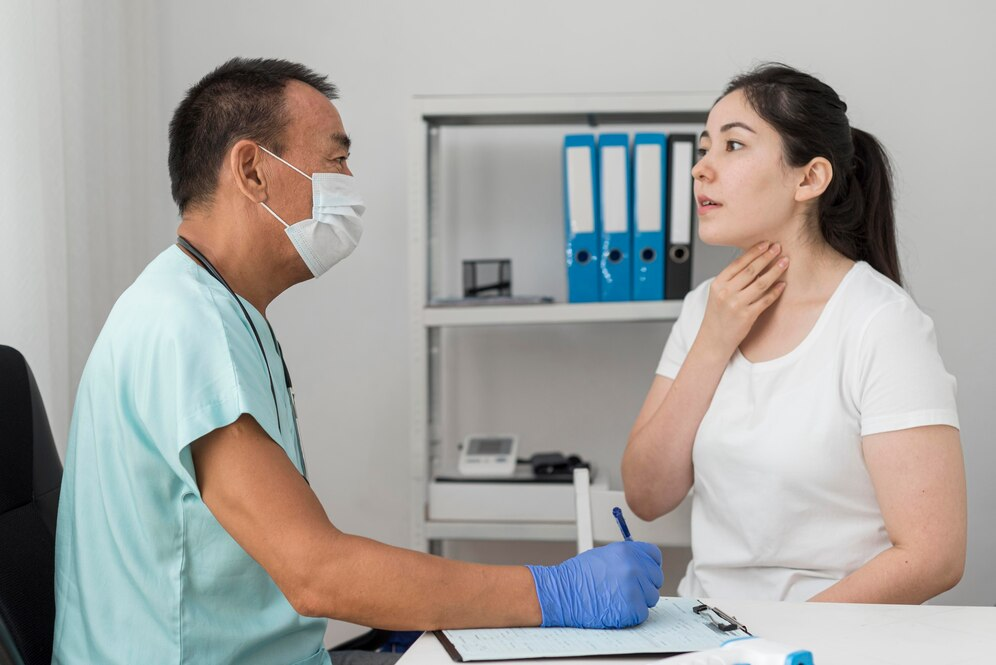Cista krajnika: simptomi, uzroci i liječenje


Ciste krajnika su manje, zaobljene otekline ili vrećice napunjene bistrom, vodenom tekućinom u ili oko područja krajnika. Iako nisu tako rašireni kao, na primjer, tonzilitis, mogu dovesti do bolova, oticanja i drugih manifestacija koje sugeriraju posjet liječniku. Ovaj članak nudi opsežne informacije o cistama, znakovima, uzrocima, dijagnozi i pristupima liječenja.
Tonsil su dvije limfne žlijezde ovalnog oblika smještene na stražnjem dijelu grla. Lokalno, oni su dio tijela imuniteta jer snimaju klice koje pronalaze svoj put kroz usta ili nos. Međutim, ciste se pojavljuju na krajnicima i trebaju liječenje ako postanu simptomatski ili postanu dovoljno veliki da bi postavili neki rizik za zdravlje pojedinca.
Vrste cista koje utječu na krajnike uključuju:
Ako na krajnicima imate upalu grla i bijele ili žute mrlje ili gnoj, mogli biste imati:
Cista na krajnikama jedan je od najuočljivijih znakova, uključujući natečeno područje na stražnjem dijelu grla. Iako bi cista mogla biti mala, može dovesti do povećanih krajnika zbog formiranja ciste. Ako je cista s jedne strane lica, oteklina je više na toj strani. Ponekad uvećani krajnik blokira dišne putove, otežavajući disanje ili gutanje hrane.
Bolno grlo je još jedan znak koji se obično javlja s cistama krajnika. Bol je obično uzrokovana upalom ciste. Općenito je blag do umjeren, ali može napredovati do teških ako se cista zarazi. Bolno grlo je slično tonzilitisu, ali bol je obično ograničena na područje oko ciste.
Kako se cista povećava, uzrokuje poteškoće u gutanje hrane, koja se naziva disfagijom. To postaje složenije, pogotovo kada jedete ili pijete, jer veliki tonsi blokiraju grlo. U nekim slučajevima cista može proizvesti bol pri gutanju hrane, a neki osjećaju da je hrana zaglavljena u grlu.
Ciste krajnika mogu uhvatiti klice i druge čestice, što rezultira halitozom ili gadnim dahom. Bakterije koje se akumuliraju u cisti dovode do neugodnog mirisa, posebno ako se cista zarazi. Sluz i mrtve stanice također će se gomilati i uzrokovati ovaj simptom, čak i ako niste zaraženi.
Iako je cista u grlu, ona može uzrokovati i upućenu bol u ušima. To je zato što postoji standardna opskrba živaca za grlo i uši. Većina ljudi s cistama na krajnikama navodi da imaju dosadnu ili ošpu bol u jednom ili oba ušiju iako nemaju infekciju uha.
Ovisno o njihovoj veličini, ciste na krajnicima mogu uzrokovati izmjenu glasa jer se pritiskaju na glasnice ili ometaju protok zraka. Cista ometa glas, a glas zvuči slabo, promuklo ili nosno. Ovaj se simptom obično vidi kod ljudi s više divovskih cista od ostalih.
Ponekad se na stražnjem dijelu grla viđa cista krajnika kao natečena, bijela ili žuta kvrga. To se obično otkriva tijekom općeg pregleda liječnika ili osobe same kad provjeravaju grlo s ogledalom.
Postoji nekoliko uzroka koji dovode do stvaranja cista krajnika. Poznavanje uzroka može pomoći u prevenciji formiranja ciste, kao i pravilnoj skrbi za pacijente s cistama.
Ponavljane infekcije na krajnicima uzrokuju formiranje cista. Upala i opstrukcija kriptovaluta krajnika, koji su mali prostori na krajnicima, posljedica ponavljajućeg tonzilitisa ili drugih infekcija. Takve blokade napreduju i formiraju ciste jer se u njima počinje sakupljati tekućina.
Kamenje krajnika, obično poznata kao tonziloliti, male su betone koje se razvijaju u kriptima krajnika. Ta je kamenje obično benigno, ali mogu stvoriti ciste ako rastu ili uzrokuju probleme s opstrukcijama. Tonziloliti nastaju kada se akumuliraju krhotine hrane i mrtve stanice, što dovodi do stvaranja ciste.
Ciste krajnika nastaju kada se sluz akumulira u kriptama krajnika. Zvučnici također izlučuju sluz; Ako su kripte blokirane, sluz tvori cistu. Ovaj je postupak analogan stvaranju cista za zadržavanje sluznice u drugim područjima tijela, uključujući sinuse.
Također je važno napomenuti da su neki ljudi genetski predisponirani da imaju ciste na krajnjim dijelovima zbog urođenih teškoća. Ovi nedostaci mogu promijeniti arhitekturu krajnika, što rezultira blokadama i zadržavanjem tekućine.
HPV je povezan s formiranjem cista u grlu, uključujući i krajnike. Neke vrste HPV -a mogu dovesti do stvaranja benignih tumora u tkivu grla, što tvori ciste. Iako nije toliko čest kao drugi uzroci, to treba uzeti u obzir u bolesnika s poviješću HPV infekcije.
Dugoročni kontakt s alergenima ili drugim agensima koji iritiraju na krajnikama uzrokuje upalu i, nakon toga, stvaranje cista. Ljudi koji imaju kronični rinitis ili postnazalni kapaljci vjerojatno će razviti ciste na krajnjim slovima zbog trajne upale.
GERD rezultira regurgitacijom kiselina u grlu, uzrokujući upalu krajnika, što dovodi do stvaranja ciste. To je posebno tako kod ljudi koji imaju refluks kronične kiseline jer su tkiva krajnika redovito izložena želučanoj kiselini.
Ciste krajnika mogu se dijagnosticirati fizičkim pregledom, poviješću medicine i nekim dijagnostičkim testovima. Stoga je važno postaviti ispravnu dijagnozu kako biste odredili ispravno liječenje.
Prvo, pružatelj zdravstvene zaštite fizički će ispitati pacijentovo grlo i krajnik. Ako je cista dovoljno velika, možda bi je mogla vidjeti kao malu kvržicu na krajnjim krajnicima. Pružatelj zdravstvene zaštite može upotrijebiti depresor jezika kako bi bolje pogledao grlo. Ponekad se malo kamera nazvanog endoskop koristi kako bi se bolje pogledao u grlo.
Ako se cista ne može lako vidjeti, daljnje dijagnostičke testove, uključujući ultrazvuk, CT skeniranje ili MRI, rade kako bi se otkrila i utvrdila njegova veličina. Takvi testovi otkrivaju detaljne slike krajnika i susjednih tkiva, što pomaže u određivanju je li cista benigna ili zahtijeva više preporuke.
Ako cista izgleda atipično ili ako postoji sumnja na rak, provodi se biopsija. To podrazumijeva uzimanje malog dijela tkiva iz ciste za obavljanje nekih testova u laboratoriju. Biopsija može utvrditi je li cista benigna, neoplazma ili zaražena.
U slučaju infekcije, liječnik provodi test grla ili krvi kako bi potvrdio prisutnost bakterijske ili virusne infekcije. Poznavanje uzroka bolesti može biti korisno u upravljanju slučajem, posebno ako su opravdani antibiotici ili antivirusni lijekovi.
Postoji nekoliko načina na koje liječnici tretiraju ciste na krajnicima, a oni uključuju: Većinu vremena ciste krajnika ne trebaju intervenciju; Oni liječe sami. Međutim, ako je cista bolna ili stvara neke smetnje, mora se posjetiti liječnika ili kirurga.
Ako je cista na krajnicima mala i nema simptoma, liječnik savjetuje pacijentu da se suzdrži od intervencije i umjesto toga prati cistu. Ovaj se pristup obično preporučuje pacijentima s cistama otkrivenim tijekom rutinskih pregleda ili kada pacijent ima prilično blage simptome. Cista se povremeno prati ispitima za provjeru kako bi se vidjela je li izrasla ili je uzrokovala bilo kakve druge probleme. U mnogim se slučajevima stanjem može upravljati budnim čekanjem, bez daljnjih intervencija ako se ne pojave simptomi. Male ciste na krajnjim krajama mogu se ne liječiti i samostalno nestati bez medicinskog tretmana. Neke studije provedene u NHS klinikama pokazale su da 40-50% asimptomatskih slučajeva ne napreduje i ne treba nikakvu daljnju intervenciju. Savjetuje se da se vratite svakih 3-6 mjeseci ili tako za pregled promjena. Rutinski pregled obično je sve što je potrebno, osim ako nema novih simptoma kojih se treba brinuti.
Antibiotici se koriste u procesu liječenja ako je cista posljedica bakterijske infekcije ili se zarazila. To je posebno korisno u slučajevima cista koje su posljedica tonzilitisa, peritonsillarnog apscesa ili kroničnog tonzilitisa.
Uobičajeni antibiotici: Obično se uzima penicilin ili amoksicilin, ali liječnici se odlučuju za klaritromicin za bolesnike s alergijama na penicilin.
Trajanje liječenja: Prosječno razdoblje liječenja antibioticima je 7 do 10 dana. Za kronične infekcije liječenje traje duže ili se mora ponoviti nekoliko puta.
Učinkovitost: Antibiotici mogu pomoći u smanjenju upale i boli i spriječiti rast bakterija. Unatoč tome, antibiotici ne mogu ukloniti cistu ako nema infekcije.
Komplikacije: Zlouporaba antibiotika jedan je od razloga što je otpornost na antibiotike veliki problem u Velikoj Britaniji. U trenutnom svijetu, pružatelji zdravstvenih usluga pacijentima ne propisuju lako antibiotike jer su sigurni u infekciju.
Drugim riječima, kirurška drenaža se savjetuje je li cista velika ili bolna. To podrazumijeva stvaranje malog rezanja ciste i pražnjenje zarobljene tekućine kako bi se ublažili simptomi poput poteškoća u gutanjem, boli ili opstrukcije. To je obično dnevni postupak slučaja, a pacijentu se obično daje lokalna anestezija. Cista je izrezana kako bi se oslobodila tekućina zatvorena u njoj. Oporavak je relativno brz, a većina ljudi može se vratiti u svoju rutinu u roku od dana ili dva. Učinci ublažavanja boli su gotovo trenutni. Kirurška drenaža nije ljekovita, a cista se vraća ako uzrok korijena nije riješen. Na temelju literature, procijenjeno je da 20-30% pacijenata dobiva relaps nakon drenaže, ovisno o stanju pacijenta. U britanskim klinikama kirurška drenaža koristi se u 15-20% slučajeva teških simptoma ciste.
Ovaj se postupak obično vrši za pacijente koji imaju ponavljajuće ciste na krajnicima ili kronični tonzilitis. Ovo je kirurški postupak u kojem se uklanjaju svi krajnici, a to je trajno rješenje cista i ponavljajućih infekcija.
Tonsillektomija se vrši pod općom anestezijom; Pacijent se obično prihvaća na jednu noć u bolnici. To je relativno uobičajena operacija. Međutim, oporavak traje od jednog do dva tjedna. Tonsillektomija je najučinkovitija i najučinkovitija metoda liječenja cista na krajnjim krajnicima s visokom učinkovitošću. Istraživanje u Ujedinjenom Kraljevstvu izvijestilo je da se problemi povezani s cistom mogu izliječiti na više od 90 posto pacijenata koji su podvrgnuti tonzilektomiji, posebno onih s kroničnim tonzilitisom. Primarne komplikacije uključuju posthirurško krvarenje i infekciju. Vrlo je malo nuspojava koje se mogu pojaviti korištenjem anestezije, a one su rijetke. To je još uvijek rijetko, ali takve su se komplikacije značajno smanjile zbog razvoja kirurških postupaka. Tonsillektomija je i dalje rasprostranjena u Velikoj Britaniji, a NHS godišnje provodi preko 35 000 tonzilektomija. Iako je većina operacija namijenjena kroničnom tonzilitisu, mnoge su također učinjene za ponavljajuće ciste krajnika i druge bolesti krajnika.
Laserska ablacija je kirurški postupak koji koristi lasersku svjetlost za uklanjanje ciste razbijajući je. To je relativno nedavni pristup liječenju ciste i obično se koristi umjesto operacije u slučajevima manjih ili plitkih cista.
Laserska ablacija najčešće se izvodi pod lokalnom anestezijom. Laserske grede usmjerene su na cistu bez povrede drugih dijelova tijela; To smanjuje upalu i šansu za ožiljke. Oporavak je brži od operacije; Većina pacijenata može se vratiti u svoju rutinu za dan ili dva. Značajne prednosti laserske ablacije su visoka točnost i kratko razdoblje rehabilitacije. Također minimizira šanse za pojavu iste bolesti. Treba napomenuti da je stopa recidiva nakon laserskih postupaka 10-15%, dok je ona tradicionalne kirurške odvodnje veća. Laserska ablacija nudi se u nekim određenim ENT klinikama u Velikoj Britaniji; Međutim, nije toliko popularna kao tonsilektomija ili konvencionalna operacija zbog troškova i potrebne opreme.
Nekoliko kućnih lijekova pomaže u smanjenju simptoma cista krajnika kod osoba s malim cistama ili onima koji se nisu odlučili za operaciju. Međutim, ti lijekovi mogu samo ublažiti simptome i ne liječiti cistu.
Ispiranje grla toplom slanom vodom također pomaže u smanjenju oteklina i boli. Također pomaže u održavanju čistoće područja i minimizira šanse za dobivanje infekcije. Ibuprofen ili acetaminofen mogu se kupiti bez recepta i pomoći u upravljanju boli i upalom. Pružatelji zdravstvenih usluga preporučuju ih za ublažavanje boli u udobnosti pacijentovog doma. Uzmite vodu i upotrijebite ovlaživač kako bi grlo učinilo manje suhim ili bolnim i na taj način lakše se nositi sa simptomima.
Ciste krajnika uglavnom nisu zloćudne, ali ako nisu riješene, mogu uzrokovati probleme, pogotovo ako su velike ili zaražene.
U teškim slučajevima, ogromne ciste na krajnicima blokiraju dišne putove, otežavajući disanje. Ovu medicinsku hitnu situaciju treba riješiti što je prije moguće. Neki simptomi uključuju poteškoće u disanju, zvuk zvižduka tijekom disanja ili osjećaj gušenja.
Ako cista na krajnikama dobije infekciju, to se naziva i tonzillarni apsces. Ovo se stanje naziva peritonsillar apsces, u kojem gnoj tvori kolekciju oko zahvaćenog krajnika. Apsces može biti vrlo bolan, uzrokovati vrućicu i uzrokovati probleme koji gutaju hranu. U tu svrhu preporučuje se da liječnik liječi zahvaćeno područje kako bi isušio apsces kako bi zaustavio širenje infekcije.
Iako je cista zaražena, ona uzrokuje nelagodu i bol, posebno prilikom gutanja hrane. To može biti vrlo iscrpljujuće i također može ograničiti nečiju sposobnost jela, razgovora ili čak spavanja.
Ciste krajnika vraćaju se nakon liječenja, posebno ako se uzrok ne liječi. Neki uvjeti zbog kojih osoba vjerojatno trpi ponavljajuće ciste uključuju kronične infekcije, alergije ili kamenje na krajnjim slovima.
Da bi se spriječilo stvaranje cista krajnika, treba razmotriti čimbenike koji uzrokuju njihov razvoj. Iako je nemoguće u potpunosti izbjeći formiranje cista, sljedeće mjere pomažu u prevenciji formiranja ciste:
Njega krajnika uključuje sprječavanje nakupljanja bakterija i drugih krhotina koje dovode do stvaranja ciste pravilnim praksama oralne higijene. Uvijek treba četkati zube i obrisati zube i upotrijebiti ispiranje usta kako bi se usta i grlo čisti.
Pacijenti s kroničnim alergijama trebali bi se konzultirati s liječnikom kako bi pronašli načine kako se baviti svojim stanjima. Minimiziranje kontakta s alergenima, uzimanje antihistaminika ili upotrebom nosnih sprejeva također pomaže u izbjegavanju upale krajnika.
GERD se može kontrolirati prehranom, lijekovima i promjenama načina života kako bi se spriječilo stvaranje cista krajnika.
Može se pregledati od pružatelja zdravstvene zaštite i dijagnosticirane su ciste na krajnjim dijelovima prije nego što uzrokuju mnoge simptome. To omogućava liječniku da liječi stanje u ranoj fazi i, prema tome, izbjegava komplikacije.
Kakva je rasprostranjenost cista krajnika?
Većina cista na krajnicima ne predstavlja kliničke simptome, tako da ljudi s njima neće tražiti liječenje. Zbog toga istraživači ostaje da učestalost njihove pojave. Ciste za zadržavanje krajnjih tona su najraširenije ciste krajnika koje se mogu razvijati kod ljudi. Te se formacije događaju kada se blokiraju sluz. Manje od 0,01% svih cističnih lezija, nazvanih cistama epidermoida, zabilježeno je u ustima i grlu.
Tonsil su dvije limfne žlijezde ovalnog oblika smještene na stražnjem dijelu grla. Lokalno, oni su dio tijela imuniteta jer snimaju klice koje pronalaze svoj put kroz usta ili nos. Ciste krajnika su manje, zaobljene otekline ili vrećice napunjene bistrom, vodenom tekućinom u ili oko područja krajnika. Iako nisu tako rašireni kao, na primjer, tonzilitis, mogu dovesti do bolova, oticanja i drugih manifestacija koje sugeriraju posjet liječniku. Različite vrste cista koje utječu na krajnike uključuju ciste zadržavanja krajnjih krajeva, ciste epidermoide, limfoepitelne ciste i hidatidne ciste.
Znakovi i simptomi tonsillarnih cista uključuju oticanje ili proširenje uključenih krajnika, grlobolje, poteškoće u gutanju, lošeg daha, bolnih ušiju, promjene glasa i vidljivu kvržicu. Uzroci cista krajnika uključuju kronične infekcije, kamenje krajnika, zadržavanje sluznice i druge sekrecije, urođene abnormalnosti, HPV infekciju, alergije, gastroezofagealne refluksne bolesti i kronične iritacije. Pojedinci moraju tražiti zdravstvenog radnika nakon što simptome povežu s mogućim uzrocima. Zdravstveni stručnjak mora dijagnosticirati cistu krajnika uz pomoć fizičkog pregleda, lokalnih studija snimanja, laboratorijskih istraživanja i lokalne biopsije.
Uobičajene komplikacije cista tonzila uključuju opstrukciju dišnih putova, ponavljajuće infekcije grla, kroničnu bol i recidiv, pa je potrebna medicinska pomoć kako bi se izbjegli ovi neželjeni ishodi. Opcije upravljanja i liječenja ciste tonzile često uključuju razdoblje budnog čekanja da se nadgleda rast cista i rezultirajući simptomi, kućna skrb, simptomatsko liječenje, liječenje antibioticima, kirurška drenaža ciste, lasersku ablaciju ili tonzilektomiju (uklanjanje uključenog Tonsila ).







Osim toga, u našem mjesečnom biltenu nabavite unutarnju žličicu na našem najnovijem sadržaju i ažuriranjima.